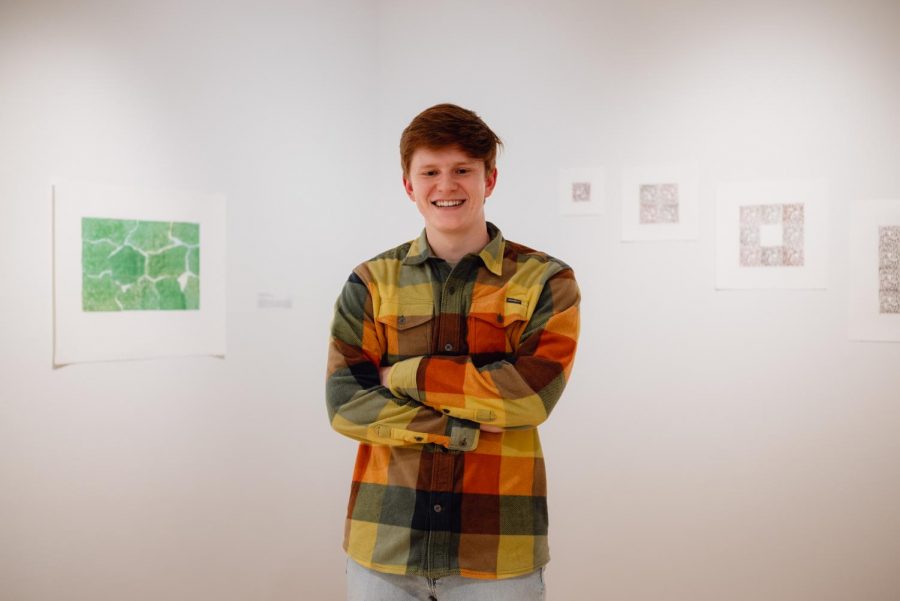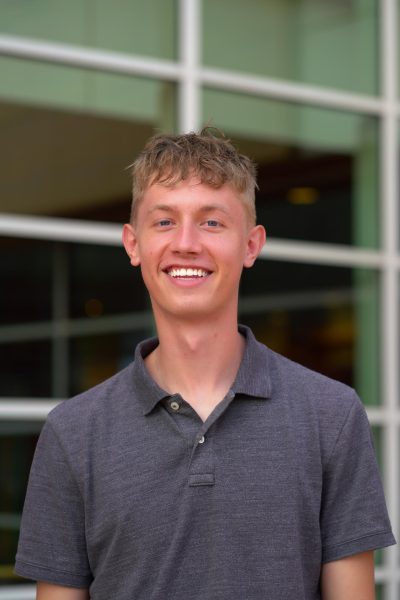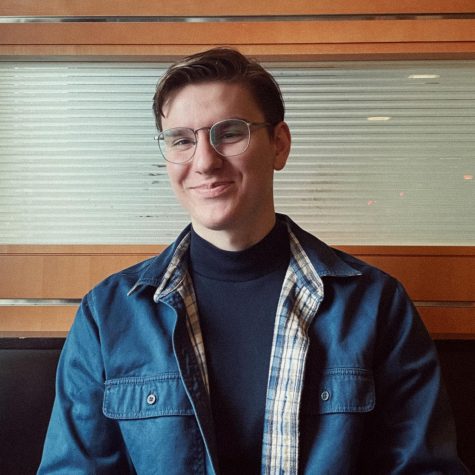“Breadth of Biology” is original, organic
Chase Holdener `23 in front of his work in Smith Gallery.
February 6, 2023
Four years of interdisciplinary studies by Chase Holdener `23 are culminating this month in an exhibition of original artwork. Holdener is double-majoring in biology and computer science, but his passion for art rivals his dedication to science. Fortunately, Holdener has not had to choose between his interests — in fact, he has combined them.
Holdener’s exhibition, “Breadth of Biology,” opened in Smith Gallery on Jan. 30 and received over one hundred visitors during the two-hour opening ceremony. The exhibition features eight prints inspired by biology that depict the diversity of life. If viewed in clockwise order, the artwork successively zooms out in biological scope from microscopic to macroscopic.
“The artwork reflects varying scales of biology from molecular in ‘Central Dogma’ to cellular in ‘Cell Suspension.’ At the organism level, I made ‘Trilobite Fossils,’ and ‘Bug Feast’ represents the ecological scale,” said Holdener, referring to the titles of his works.
Although Holdener produced all of the art on display within the past five months, the ideas were collected over four years of classes and research. One of the pieces, “Cell Suspension,” is based on a photo that Holdener captured during his summer 2022 research internship at the Donald Danforth Plant Science Center in Missouri. “We had inserted DNA into cells that contained genes for a fluorescent protein. When we imaged the cells, I saw how pretty the photo was and wanted to incorporate the image into my art,” said Holdener.
To translate the photograph into an art piece, Holdener used screen printing. “Essentially, the image becomes a highly-detailed stencil that blocks the ink, creating the art around it. I used this technique in order to replicate the precision of the image and vary the color scheme to make it visually pleasing.”
Holdener learned about screen printing from art professor Matthew Kluber’s course on print media in fall 2022. Kluber recommended that Holdener apply to exhibit in the Smith Gallery with five of the pieces he had completed in class. Upon acceptance, Holdener finished three additional pieces over winter break.
Many of Holdener’s artistic strategies come from prior classes and personal experimentation. In high school, Holdener took two art classes — two of his pieces were accepted to the Ohio Governor’s Youth Art Exhibition — and he continued his art education by taking “Introduction to Studio Art” the spring of his firstyear at Grinnell College. Holdener has found that the intersection of his artistic and academic interests offers a new perspective on science.
“When you make art about biology, it’s different from images in a textbook. I wanted to catch peoples’s eye and get them excited about artwork, but then also take away a few things about biology.” Holdener believes that his academic background has been formative in the quality of his work. “When you’re passionate about what you’re communicating, it makes for effective art.”
Holdener — who is also a Goldwater scholar, member of the biology major Student Educational Policy Committee (SEPC) and founder of the College plant club — plans to do a five-year graduate program in computational biology before pursuing a career in biology research. “I can see myself becoming a professor. Academia would likely offer me the most freedom in deciding what I want to research,” said Holdener.
To Holdener, this exhibition is a reminder that breadth and depth are not mutually exclusive. Instead, intense dedication to numerous fields can strengthen understanding. “I learned that you can enjoy biology and computer science before switching gears to make an art show. It’s all interdisciplinary. Capitalize on the freedom to intertwine your goals.”
Holdener’s exhibition, “Breadth of Biology,” is open through Feb. 10 in Smith Gallery (located inside the Joe Rosenfield Center). Smith Gallery applications are announced bi-annually by the art SEPC and art department. Applicants must be studio art or art history majors, or be currently enrolled in a studio art course.


















































